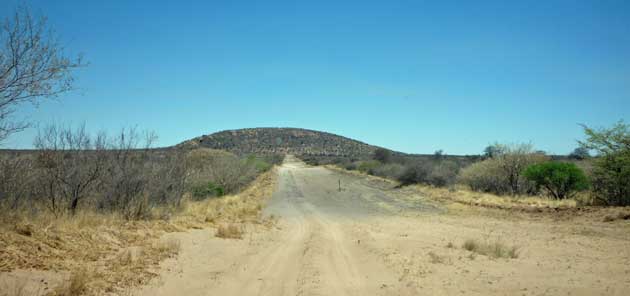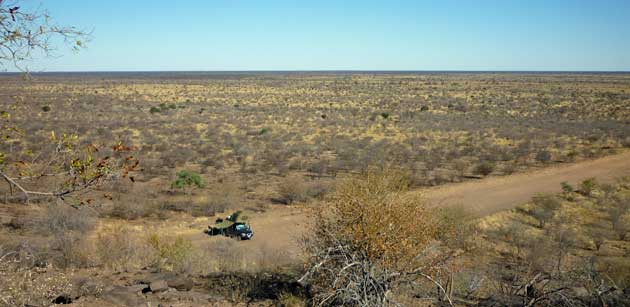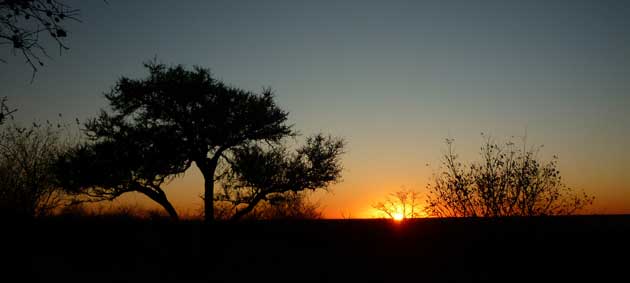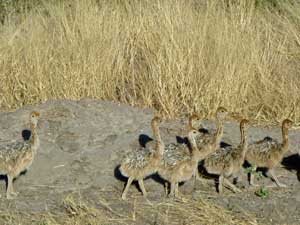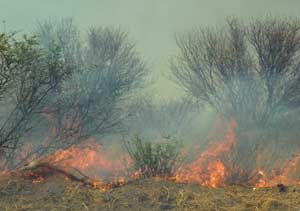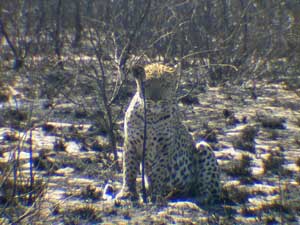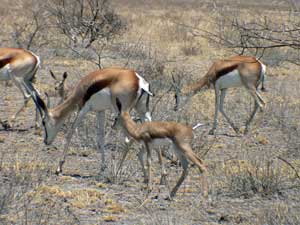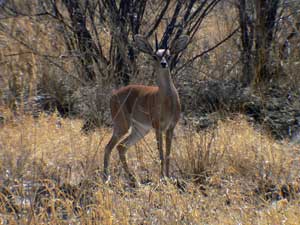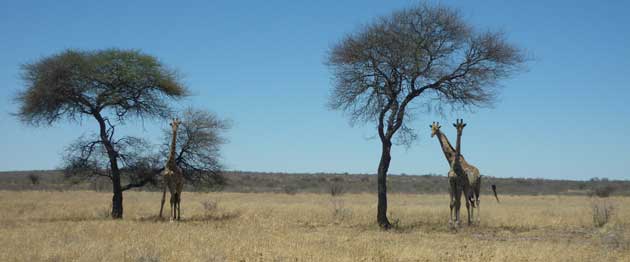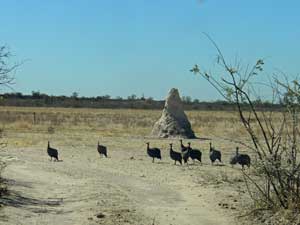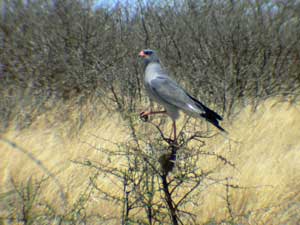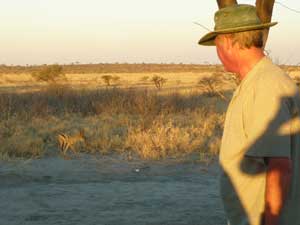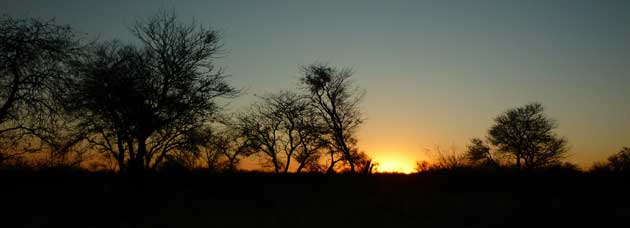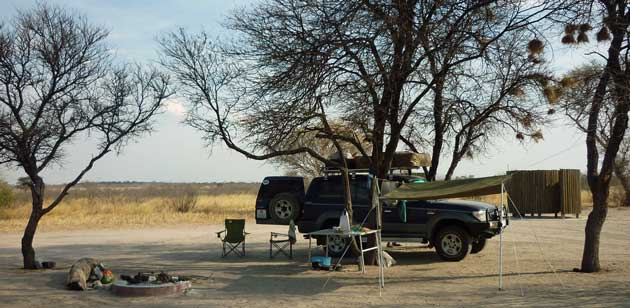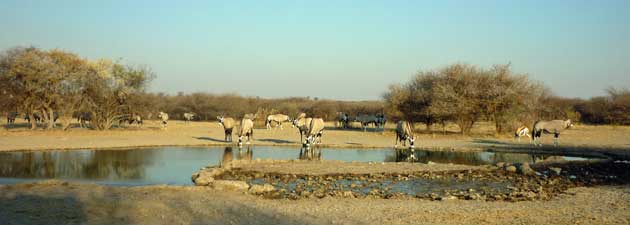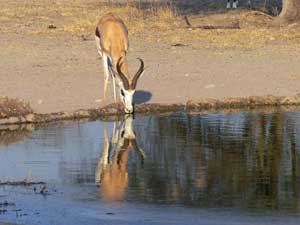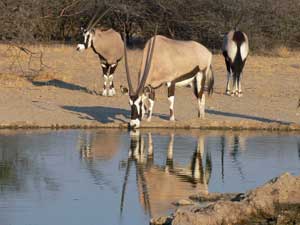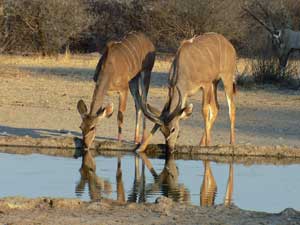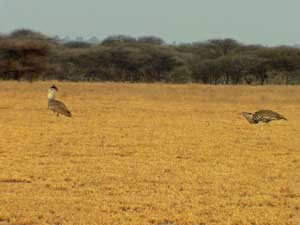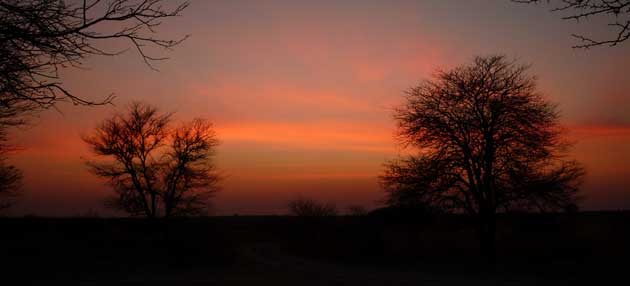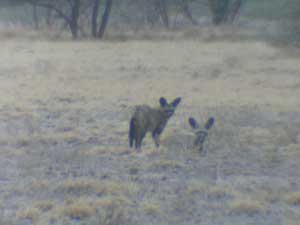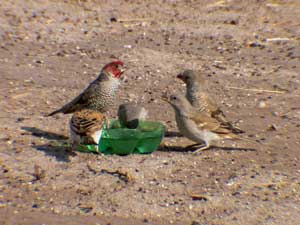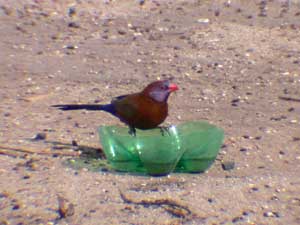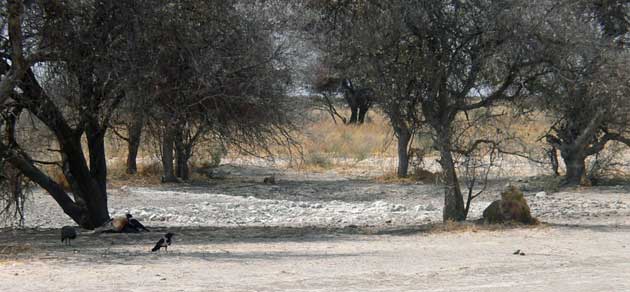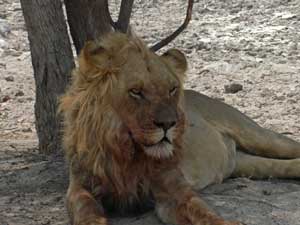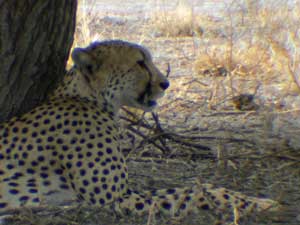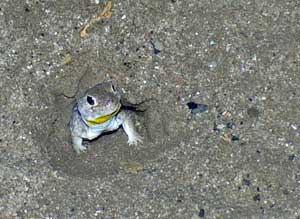

South Africa
Southern Africa
UK
Campsites (Africa)
We'd booked 5 nights in the Central Kalahari but the first site was quie along way from Ghanzi so I'd asked Chris, at Thakadu, if there was somewhere that we could camp near the Tsau Entrance Gate and he suggested that we wild camp near the Tsau Hills. From the entrance gate we drove south along the cut line (A cut line is basically a straight line cut through the bush, about 20m wide, which acts as a fire break) for 25km until we reached the hills..... ....and set up our camp at the foot of the hills. Sunset. The next morning, on the way back to the Park gates, we saw quite a lot of game on the road – kudu, gemsbok, steenbok, ostriches and a giraffe. Yesterday we'd seen a pair of ostriches with chicks and we saw them again this morning. At the Tsau Entrance Gate we met 2 German couples who we'd seen at Thakadu. They had started driving into the Park yesterday but had turned back because of a bush fire and said that they’d decided not to go into the Park but to drive to Maun. They’d tried to get information about the state of the fires from the girls at reception but hadn’t had much success. We booked in and set off. . We could see smoke in the distance and after 20km reached a section with fire to our right however as the track was 20m wide we were able to drive past without any problem. We did stop to say ‘hi’ to a tortoise but he was tucked away in his shell and hopefully safe from the fire as he was right by the fence on the left of the cutline which was certainly stopping the fire from spreading to the other side. We saw some kudu near the fence, all but one of them ran off into the bush but one jumped right over the 2m fence from standing – we’d be told before that they can clear 3m Kudu near the fence. Part of the bush fire to the right of our vehicle. Later we turned south along a narrow track away from the cutline. This area had obviously been burnt recently on both sides of the track as most of the shrubs and grass were blackened and some bits of wood were still smoldering. Suddenly I saw a cat walking through the fire damaged bush. As soon as it heard us it lay down beside a bush, it was a leopard. It lay there for several minutes before sitting up and then getting up and walking away. If it hadn’t been for the fire we’d never have seen it in the grass! Further into the park, near Passarge Pan, there was much less fire damage and we started to see some game. Sprinbok with calves. A steenbok. As we drove along Passarge Valley the landscape changed. Many, many years ago this was a valley but no longer, now it’s a long wide depression with lots of grass, some bushes and occasional trees. We saw very little game – not too surprising as it was hot by now – but we did see a group of 3 giraffe in the shade of some trees. 2 of them were lying down but got up as we approached. Guinea fowl passing in front of one of the many termite mounds that we saw. A pale chanting goshawk on the lookout for insects. Our camp, Passarge Valley number 2, (S21 16.115 E23 28.619) was under a group of 6 trees. Around sunset a jackal appeared near the shower and walked towards our camp, then it noticed us and stopped. It then moved off into the bush and walked around the camp, mostly keeping a metre or so into the bush but, once, it came right into the camp before heading off towards the track. Sunset. The next day we carried on driving along Passarge Valley. From time to time we would see 'island trees' - a group of trees that looked a bit like an island in the middle of the valley. We saw several groups of gemsbok and springbok. This was our second campsite at Sunday Pan site 2 (S21 21.100 E23 40.282). As with the other camps in the Park it had a long drop toilet and a bucket shower - you have to provide your own water. The following morning we drove down to the waterhole. There were plenty of gemsbok and birds around but no sign of any cats unfortunately. Gemsbok at Sunday Pan waterhole. The water was quite still so I tried to get some photos of game with their reflection. Sprinbok. Gemsbok. Kudu. We drove around some of the pans. As well as plenty of springbok and gemsbok we also saw lots of birds. There were plenty of black korhaan's which would fly off with a loud cry as we approached. Kori bustards are the largest birds that can fly. The male, on the left, is displaying to the female. Sunset. As we were driving back to our campsite after sunset we saw a pair of bat-eared foxes. After a couple of days at Sunday Pan we moved on to Kori Camp number 2 (S21 25.391 E23 47.747). We needed to transfer some water from our 25l container into 5l containers and as we were doing this a fork tailed drongo flew down and started trying to get some water so once we’d finished we fashioned a bowl by cutting off the bottom of a 2l pop bottle, filled it with water and put it on the ground. Within a few minutes the drongo was drinking from it. . During the afternoon we saw great sparrows, white-browed sparrow weavers, black faced waxbills cape glossy starlings, grey headed sparrows, violet eared waxbills, red eyes bulbuls and masked weavers at the bowl. The waterhole at Deception Valley was dry so we decided to drive out to Letiahau waterhole. It was another very hot day so we saw plenty of animals sheltering under trees and bushes. The waterhole turned out to be dry... However we did then see a lion lying under a tree a few metres from a springbok carcass. He took no notice of us so we were able to drive quite close. We then drove around the waterhole area to see if we could see any lionesses hidden in the trees and grass but no luck. There were a couple of jackal lying in the shade, either they’d already eaten or didn’t want to approach with the lion so close. On our way back to our camp we spoke to a couple who said that they'd seen a cheetah at Deception Pan so we went to try and find it. It was lying in the shade of a tree, we watched it for a while - it hardly moved at all - and then drove on. Every evening in the Kgalagadi Transfrontier Park and the Central Kalahari we would hear barking geckos - actually it was more of a 'chirp, chirp, chirp', rather than a bark. 1. Mabuasehube area of the Kgalagadi Transfrontier Park. 2. Masetleng Pan in the Kaa Concession. 3. Central Kalahari Game Reserve. 5. Savuti area of Chobe National Park. 6. Chobe National Park - Riverfront. Diary (Word '97 document). One evening I managed to locate one of the geckos by listening to its' barking' and eventually found its hole. It was tiny, its head was only about the size of my small fingernail! When it ‘barked’ it drew its head back into its burrow a little way – this increases the noise because the hole amplifies the sound, according to one of our guide books.
Botswana, October 2010 - Central Kalahari National Park
